Greetings, fellow Stormlight Archive fans and cosplay aficionados! Planning a cosplay from the Stormlight Archive for the upcoming Oathbringer book tour, a convention, or for your own enjoyment? If so, you’re in luck! I’m here to help with the first in a series of articles designed to help you put together the perfect Cosmere cosplay, regardless of your skill level. From beginners who have never picked up a needle and thread to award-winning experienced costume masters, you’ll find everything you need in one convenient location, from pattern recommendations to fabric choices to in-text descriptions. So pull up a chair, pour yourself some blue wine, and let’s talk fashion!
There will be some slight spoilers for Words of Radiance contained in this article, so if you haven’t read book 2, proceed with caution.
I’d like to take one moment here to say that if you choose to buy your outfits or commission them from someone else, it doesn’t make you any less of a cosplayer. Some choose to make everything from scratch and compete in their costumes, while others cosplay to express their love of the characters or the story. Both are cosplay, and neither is superior to the other. The key to cosplay is fun. If you’re having fun, you’re doing it right. All the things that I’m about to write from here on out are suggestions, not rules as to how things have to be. If you want to make your uniform in navy blue or green instead of cobalt blue, go for it! Like your havah with a tighter skirt? Rock it, brightlady. I often deviate from the textual descriptions because I find a design element that is more aesthetically pleasing to me, and I’d highly recommend that you do the same.
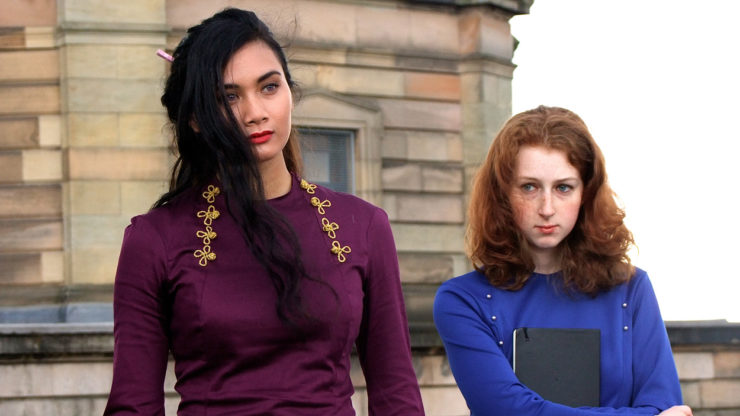
With that out of the way, let’s begin! It’s always challenging to put together a costume from a novel. Without concrete canonical images of the outfits and characters, it can be difficult to create a recognizable version of the clothing worn. However, Stormlight fans are a bit luckier than most, as Sanderson has given us a lot of very clear descriptions and some things that make costumes from his worlds unique. The most common cosplays I’ve seen from Stormlight Archive are the Alethi uniforms and havahs, so we’ll start there with this series. I’ve spoken with several fellow cosplayers and historical re-enactors in regards to patterns, techniques, and designs used, and I’ll break those down here with parts for beginner, intermediate, and experienced costumers. But first, what do the books have to say about the outfits?
The Kholin Army / Alethi Uniforms
“That uniform has a certain… timeless quality to it. The military suit, by virtue of its utility, will never be completely out of fashion.” The Way of Kings (p. 821)*
The modern Alethi officers on the shattered plains appear to wear open-fronted frock coats similar to the second continental uniforms in the Revolutionary War, and for the lower ranked soldiers, closed double-breasted frock coats worn in the American Civil War style. I’ve sent some designs and sketches off to Isaac Stewart (one of Brandon’s artists) in regards to Alethi uniforms, and he’s verified that the military uniform types outlined above are pretty close. With no official artwork other than Michael Whelan’s cover art for Words of Radiance, which isn’t wholly accurate to the textual description, and little in the way of concept art or in-book sketches, we’ve got to give it our best guess. The nice thing is that this allows us some artistic freedom when it comes to the aesthetics! For instance, I personally prefer the contrast of white or tan britches as opposed to matching blue trousers, especially for the officers’ uniforms. I also found that I really liked the aesthetic of the skirt on this frock coat, with the accent color inside the back tails, so I chose to use that design on my own captain’s jacket.
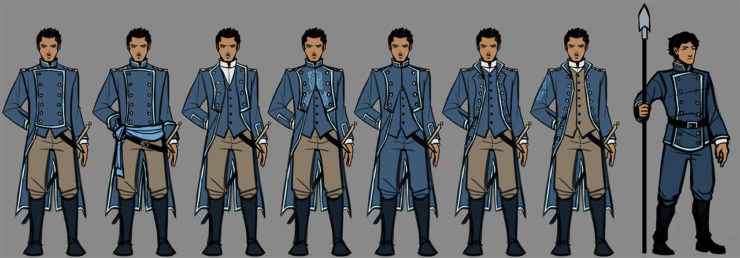
For a starting point, check out this fantastic array (above) of different visualizations of the uniform by ExMachina over on the 17th Shard forums. The two uniforms on the left and the one on the far right seem to be closer to lower ranked soldiers’ uniforms, whereas the others would most likely be officers, going by textual descriptions.
Words of Radiance Era Bridge Four Uniform
The general Bridge 4 uniform is described in Words of Radiance as follows: “Stiff blue trousers and black boots polished to a shine. A buttoned white shirt, only the edges of its collar and cuffs extending beyond the jacket, which came down to the waist and buttoned closed beneath the belt” Words of Radiance (p. 61).
The belt, it stands to mention, is described as having a buckle. The members of Bridge Four wear the Bridge Four patch on the shoulder of their uniforms—on the right shoulder, if the passage about Lopen stands true for all the soldiers (he pulls the left sleeve inside the jacket and points to the patch on the other sleeve). Nothing is mentioned about epaulettes, but “knots of rank” are mentioned several times throughout the course of both books.
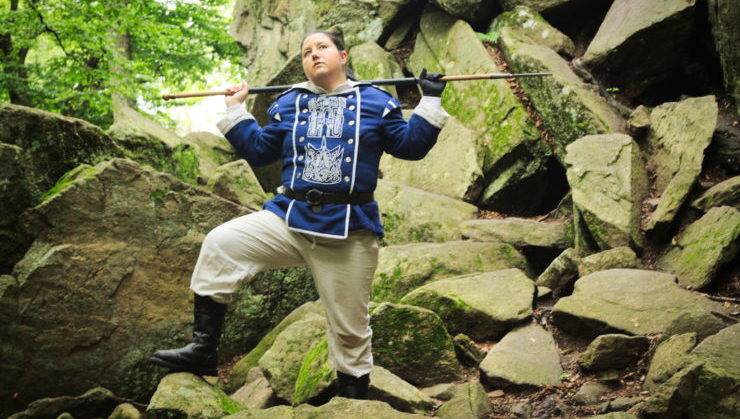
Kaladin’s Captain Uniform and High Officer Uniforms
Kaladin’s captain uniform “was different. It included a blue waistcoat and a double-breasted blue longcoat, the lining white, the buttons of silver. The longcoat was meant to hang open, despite the rows of buttons down each side” Words of Radiance (pp. 63-64). Later on in that book, the coat is described as coming down to his knees.
Adolin and Renarin (before he joins Bridge Four) wear high officer’s uniforms. They are generally described as more lavish than the common soldier’s uniforms, “with bright buttons up the sides of the fine coats and gemstones set into the buttons. Others ornamented their uniforms with embroidery. Colorful scarves were growing popular” Words of Radiance (p. 499).
Adolin in particular wears “a simple blue outfit of militaristic cut. A long coat of solid blue—no embroidery—and stiff trousers in a time when vests, silk accents, and scarves were the fashion. His father’s Kholin glyphpair was emblazoned quite obtrusively on the back and breast, and the front fastened with silver buttons up both sides” The Way of Kings, (p. 277). He is also described as having “Monogrammed buttons, boots that cost more than some houses, [and a] side sword” in Words of Radiance (p. 636).
Dalinar’s dress uniform is described once, in The Way of Kings. “Dalinar wore a long, thick uniform coat over trousers and shirt. It buttoned stiffly up the chest and to the collar, and was long in the back and on the sides, coming down to his ankles, flowing at the waist like a cloak. In earlier years, it might have been worn with a takama, though Dalinar had never liked the skirtlike garments” (p. 749).
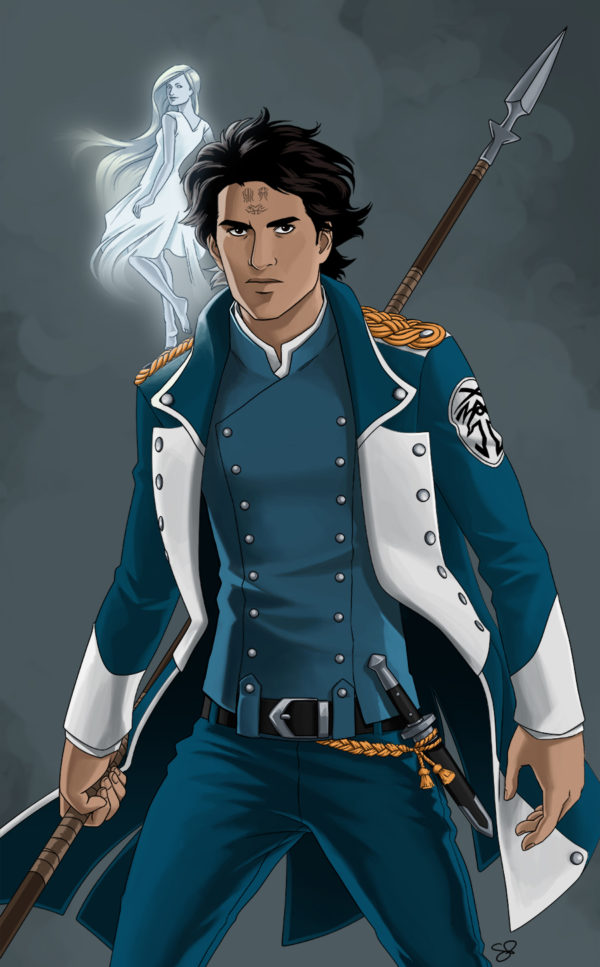
Other Alethi Uniforms
If none of these are catching your fancy, some other briefly mentioned types of uniform are:
Kaladin’s uniform while enlisted in Amaram’s army. He is described as wearing the common leathers of a spearman, but under them was a pair of dark trousers. That wasn’t supposed to be allowed. He also had knots of white cord on the shoulders of his jerkin, marking him as a squadleader. The Way of Kings (p. 39). We can infer that the common leathers include a takama: “a long, straight skirt that went down to his calves.” The Way of Kings (p. 366).
The vaulters, a special division of the armies on the Shattered Plains, use long poles to vault over the chasms and scout ahead of the main armies. All that is said of their uniforms is that they have white stripes edging the coat Words of Radiance (p. 802). I interpret this as a bias tape accent, as can be seen in most of ExMachina’s artwork above.
The female messengers of the Kholin army have their own type of uniform as well. They are described as having a “narrow skirt slit up the sides, with silk leggings beneath” Words of Radiance (p. 884). It’s worth mentioning that later in the same book, Shallan is wearing a similar traveling dress, “with the front and back slit all the way to the waist. She wore leggings—basically silk trousers … underneath” Words of Radiance (p. 924). Is the skirt slit up the sides, or the front and back? Probably an oversight, but it gives us a little wiggle room aesthetically when it comes to our designs!

Bonus Round: Alethi Formal Wear
Generally speaking, the Alethi nobility seem to prefer silk coats similar to the military uniforms with a lot of silver and gold embroidery and added frippery, like slashes to expose the lining and ruffled shirts. The Way of Kings (p. 22) (pp. 232-233). “The red silk coat was cut short and did not button; almost more of a sleeved vest, it was a mere token nod to traditional Alethi uniform. The shirt underneath was ruffled and white, and his blue trousers were loose, with wide cuffs” The Way of Kings (p. 286). “A few men wore tight, waist-length jackets, but many had dropped all pretense, choosing instead loose silk shirts with ruffled cuffs worn with matching slippers” The Way of Kings (p. 324).
So now that we have some mental images of what Sanderson envisioned, on to how you can buy or make them yourselves!
BEGINNER: You can buy some excellent replica uniform frock coats on sites like C&C Sutlery, JAS Townsend, or Blockade Runner. Depending on how much you want to spend, these coats usually start at around $200. If that price point is a bit high for you, you can also check eBay, or look around for Hamilton costumes. Historical frock coats will be a darker blue than the Kholin cobalt blue and you’ll have to add any in-world embellishments you’d want (Sanderson sells the Bridge Four uniform patch on his website). A pair of matching blue trousers or, if you want to jazz it up a little and move away from the strictly canonical, white trousers or britches (which are tighter-fitting and come to just below the knee or white trousers), a men’s dress shirt, and black boots would complete your ensemble. A waistcoat (what we today would call a vest) is an optional addition if you’re going for an officer’s uniform. Another option, if you’re not up for making it yourself, is to commission a costumer to make it for you. Any decent costumer will be expensive, however, so keep that in mind.

INTERMEDIATE: You can find some decent uniform patterns at your local fabric stores, or online. McCalls has a few pretty good patterns (1) (2) (3) that will work nicely, and they’re not too terribly complicated. Simplicity has this one that could be altered without too much work. (If you’re going for the female messenger’s uniform, check this one out. It would have to be lengthened at the bottom, but the top looks like it would be nicely fitted.) Burda has this one which could work well for an officer’s jacket & waistcoat. Look for heavy-weight cottons/broadcloth, suiting material, twill, or knits in cobalt blue. You can also sometimes find wool fabric at chain fabric stores, but it’s going to be considerably more expensive and usually navy blue instead of cobalt (not to mention hot to wear). You can make the white under-shirt if you like, but it would honestly be easier to buy a standard men’s dress shirt.
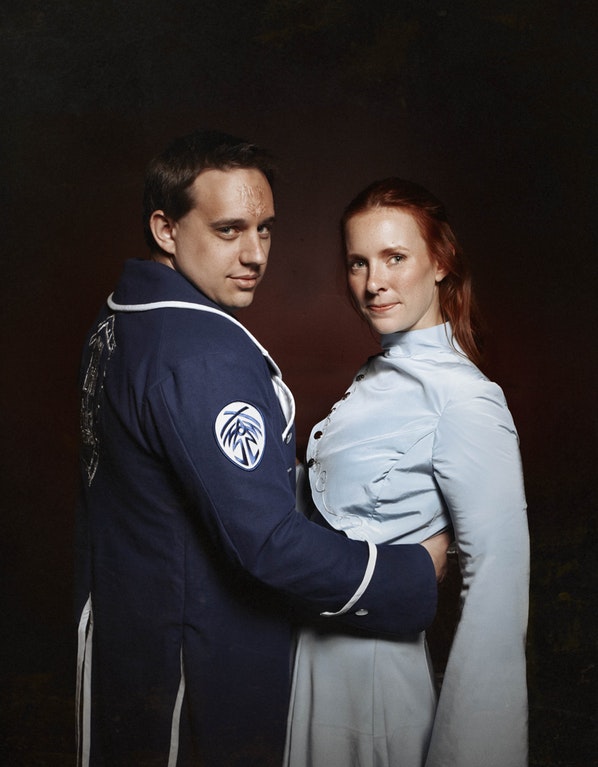
ADVANCED: First let’s talk about fabric choices. Adolin mentions that there are summer and winter versions of the uniform in The Way of Kings (p. 813). For the winter jackets, I’ve been using melton fabric (a wool/poly blend) since it’s thicker, but for a summer jacket, a thinner wool or cotton twill might be a better choice. (Check the end of this article for comments on in-world textiles if you want to be as accurate as humanly possible.)
I’ve spoken to several friends who make uniforms for historical re-enactments, and they recommend Kannik’s Korner, JP Ryan, or Period Impressions for historically accurate patterns. (Please make certain that you are checking the sizes on the JP Morgan and Period Impressions patterns. Period Impressions in particular are sized according to historical sizes, not modern.)
Historically, frock coats would be lined in linen. The white undershirt should be made from linen or cotton and would be longer than modern men’s dress shirts, falling to about mid-thigh.
An officer’s waistcoat (which could be short or long-sleeved) would also usually be made of linen. Britches were made from wool, whereas trousers were made from linen or a linen/wool blend (linsey-woolsey).
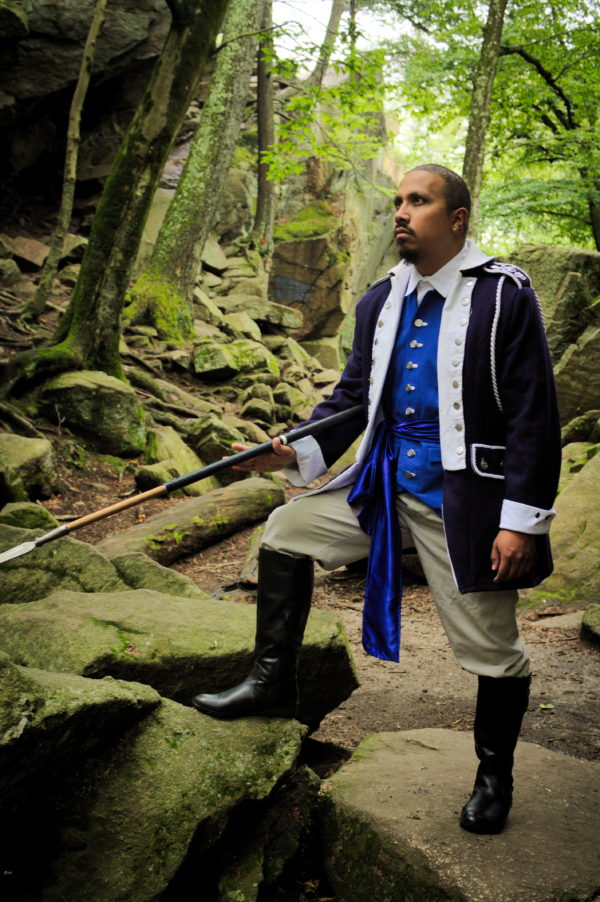
I think the knots of rank on the shoulders look better when attached to simple fabric epaulettes, but this is personal preference. For my captain’s jacket, I just bought some braided frog closures and used those for the knots of rank, though military shoulder knots would probably be more accurate.
If you have access to an embroidery machine and want to make your patches instead of buying them from Sanderson’s store (he only offers the Bridge 4 patch), you can find some high-quality images to work from here. Adolin wears an ornamental sword, so if you’re cosplaying as an officer, look into leather belts, frogs, and prop weaponry. If you like the look of the shoulder flanges from the cover illustration of Words of Radiance, they’re simple enough to add to your arm scye before you attach the main body of the jacket to the arms.
If you’d like to try adding the Kholin glyphpair to the front and/or back as described in Adolin’s uniform, there are a few different ways to do so. The easiest would be to paint it on with fabric paints (I recommend this brand, make sure you heat set it with an iron afterwards). You could also applique it (note that if you don’t want to have to sew around the edges, you can use a product called Heat n’ Bond heavy duty), or embroider it. Be forewarned, however. The Kholin glyphpair I embroidered on my bridgeman’s uniform took me over thirty hours, and it was just a simple chain stitch, not a satin stitch as I’d originally intended. This will be a time-consuming part of the project.
The Way of Kings Era Bridgeman Outfits
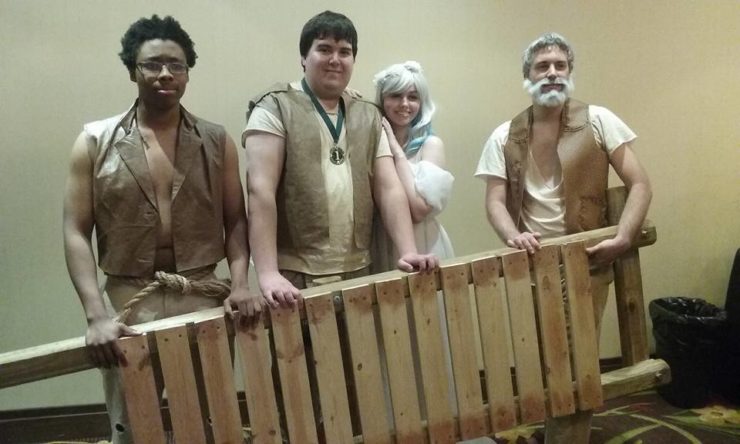
These are somewhat simple to put together (far easier and cheaper than the uniforms, if you’re intimidated by the price point of the stuff listed above!). Trousers (dirtied up and ripped, of course), lace-up sandals, and a vest with leather on the shoulders to pad them for all that bridge-running you’ll be doing will complete this ensemble. If you’d like to buy a vest made entirely of leather, check out motorcycle vests, or jerkins meant for renaissance faires like this one. If you’d like to try making it yourself, this pattern will give you everything you need (and could also double for a good Kvothe costume from Kingkiller Chronicles…). Here’s a good doublet pattern that would work as well. If you don’t have a heavy-duty sewing machine or the time/inclination to hand-sew leather, a heavy cotton broadcloth would be the perfect weight for these vests. Anthony Acker and his group of bridgemen above even built a bridge to carry around with them out of 1x4s and railroad ties!
The Havah
“Like Shallan, Jasnah wore the havah, a Vorin dress of distinctive design. The hemline was down at her feet and the neckline almost at her chin … the silk hugged the body, particularly through the bust” Words of Radiance (p. 38).
There are a few different ways of interpreting the in-text descriptions of the havah. I’ll be focusing on two: the asymmetrical side-closure type as seen in this beautiful fanart by sarctic on DeviantArt, and the front-panel technique executed to perfection by cosplayers Kate Helmly and Steph Greear below.

One thing that we’re certain on is that the dresses are meant to be one piece, rather than a skirt/bodice combo. The Way of Kings (p. 134) They’re also meant to fit tightly across the bust and torso, then flare out at the skirt (p. 66). The dresses are usually described as being brightly colored (pp. 22-23), buttoning up the sides (p. 66), and having a small collar (p. 96).
If you’re attempting specific characters as opposed to generic designs, Jasnah is described as having an outfit in violet and gold, and another in deep blue with gold embroidery. Shallan’s is described as blue. (p. 530 & 679). There may be more, but these are the three I found in a cursory search of the books.
We also need to keep in mind the most distinctive part of the Alethi woman’s attire—her safehand.
“Like all Vorin women, she kept her left hand—her safehand—covered, exposing only her freehand. Common darkeyed women would wear a glove, but a woman of her rank was expected to show more modesty than that. In her case, she kept her safehand covered by the oversized cuff of her left sleeve, which was buttoned closed” The Way of Kings (p. 66).
I’ve found that this detail is what allows me to pick out Stormlight cosplayers at conventions. The dresses, while beautiful, can sometimes be mistaken for other fandoms; but seeing that left hand covered is a instant give-away that the cosplayer is portraying a brightlady!
One last note. The hem of the bottom of the havah is designed to have a removable strip, so if the hem gets damaged due to normal wear and tear, only the strip needs to be replaced as opposed to the entire skirt (p. 134). You can see this clearly on Kate and Steph’s havahs pictured below. Fun fact: this technique is historically accurate, allowing women to continue using dresses for years.
BEGINNER: If you’re aiming for the style portrayed in sarctic’s fanart, check out some pre-made Chinese styled dresses (cheongsam or qipao) with long sleeves. The key here is finding one with the side breast closure and preferably a bit of extra fabric so you can extend the sleeve to hide your safe-hand. (If I were going this route, I’d buy two dresses, one in a much larger size, and use the extra fabric from the second dress to extend the sleeve and make the skirt a little fuller and less form fitting.) Alternatively, if you’re not feeling confident doing those alterations, you can make do with a tighter skirt and a glove for your left hand.

If you’d rather try for a design similar to Kate and Steph’s below, look for any long-sleeved dress with a full skirt. Buy a couple yards of fabric, cut it into a long rectangle and glue or sew it to the front of the dress, sew on a couple buttons, and you’ll have yourself a simple havah!
Renee spoke to me a bit about how she altered existing clothes to bring her Shallan cosplay to life. “I’m not a great seamstress and I was afraid to make a dress from scratch, so I bought a sheath dress and duster set from a thrift store. The dress was too small, so I cut the front panel away from the back, cut it at the waist and gathered it to turn it into a skirt front, which I sewed to the duster. I turned the lapels in and sewed 3 decorative seams to turn the collar into a mandarin-style. Then I found a white blouse with a mandarin collar and embroidery at another thrift store and cut the sleeves off. I sewed the end of one of the shirt sleeves to the right sleeve of the duster to give it a longer, bell-shaped cuff. Then I used the extra material from the back of the dress to make the safehand.”
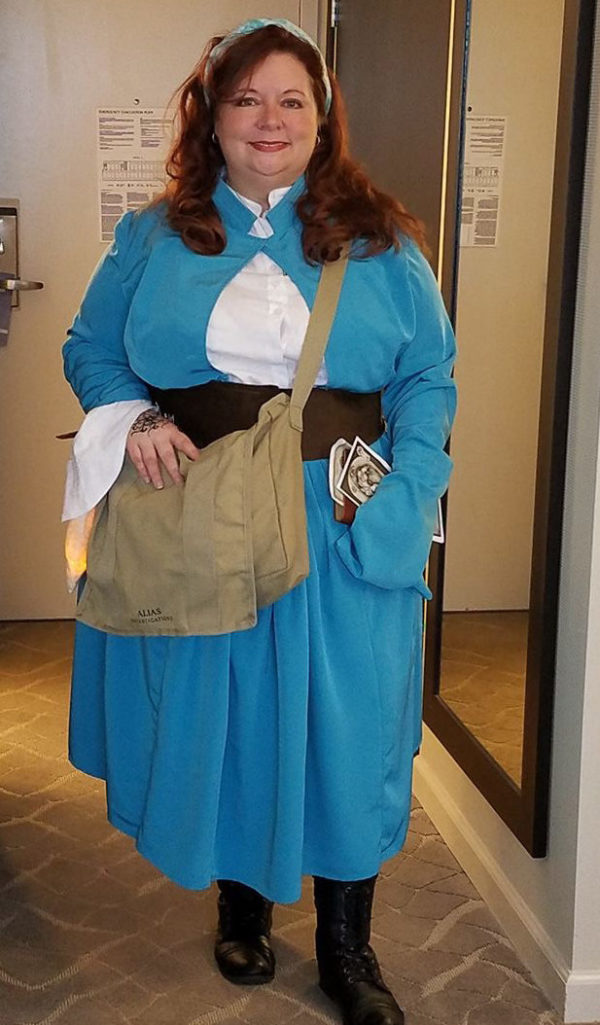
INTERMEDIATE: For sarctic’s style, start with traditional cheongsam patterns (this one is a little more challenging since it’s historical), but keep in mind that you’ll need to extend that left sleeve to make your safehand sleeve, and possibly use part of a different pattern if you want the skirt to be more full than form-fitting. A combination of the sleeves and skirt from this pattern mixed with the cheongsam top would work very nicely (pro-tip: wait until patterns go on sale at Jo-Ann fabrics! Once every few months they go on sale for a dollar or two each, which is far better than the usual $15).
Julie Brokish has a good point in regards to symmetry of style when it comes to her design. “Shallan’s gown I designed as if the military culture in Roshar influenced high fashion. I also decided to go asymmetrical. I figured if symmetry was holy, then most gowns and fashions would be asymmetrical, so as not to stray too close to what is holy.” If you’d like to read more about Julie’s costume, she has an album including some close-up shots of the embroidery here, and talks some more about the process here.
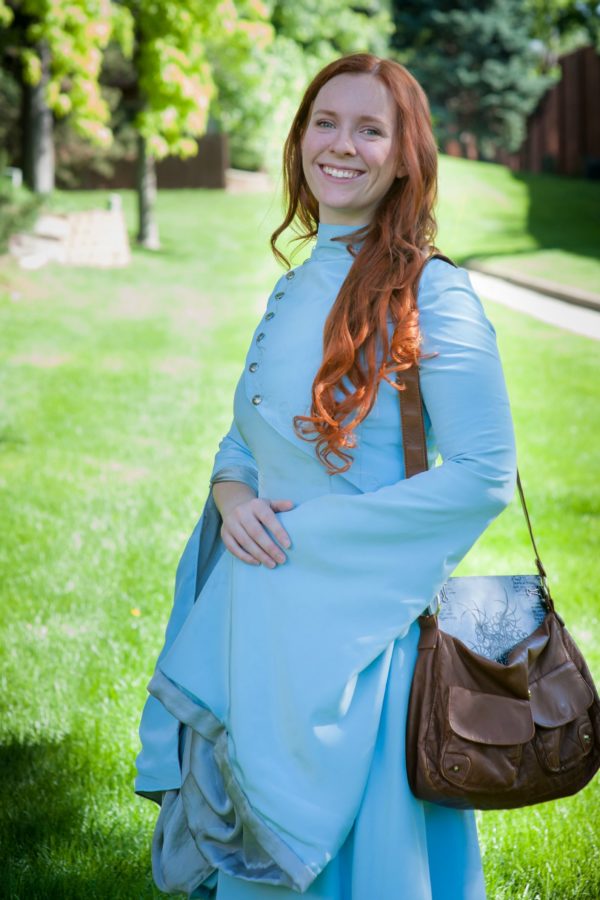
Kate and Steph used this Simplicity pattern (1009)—which is totally Cersei from Game of Thrones, Simplicity, you’re not fooling anyone—as the base for the stunning dresses pictured above and below.
“We removed the zipper and added a button strip [hereafter referred to as a pinafore] down the front,” Kate says, “then grafted on a mandarin collar. The left lower sleeve was extended to fully cover the hand and a strip with buttonholes designed to close around/within … with a pocket included (of course!).”
EXPERIENCED: The cheongsam pattern listed above in the intermediate section would work nicely for the top of sarctic’s design (keep in mind that it is described as being form-fitting).
However, you’ll need to alter the skirts considerably to give them more fullness (this pattern could be altered to do so if you’re not feeling confident enough to drape), and the left sleeve to encase your hand. Don’t forget the interior buttons for your safe-hand sleeve. You can also include a built-in safepouch for your personal items if you’re feeling particularly detail-oriented. Using silk (or tafetta as Kate and Steph did) for this dress would be preferable, but linen would also have a nice fall and would be more breathable.
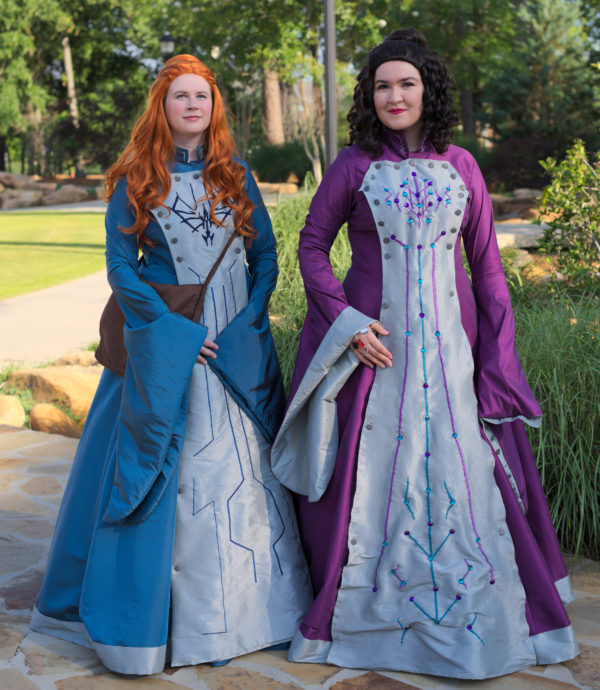
The little details and underlying aspects of Kate and Steph’s costumes are what make them so spectacular.
“Both petticoats are made of five layers of organza with a base layer that holds a hoop. Shallan’s was made with increasing fabric on each layer to make a full skirt of a young woman, Jasnah’s the same length each time to make a more diminished, matured woman’s silhouette. Both button at the waist. Both pinafores were cut to enhance the feminine lines. Shallan has a pinafore of simple embroidery, as that is what her family can afford, featuring the glyph for “Lightweaver” on the chest and stylized “Transformation” down the length. This was done using a mix of machine and hand embroidery. Jasnah is the sister of the king, and so includes “stormlight powered” glowing gemstones. These are sew-in gems, with a dremel taken to the back to open a small hole for light to shine through. LEDs were hot glued on the back of the fabric behind each gem to provide light. The patterns were marked with puffy paint then hand-embroidered on, featuring the glyph for “Elsecallers”.”
Yashuntafun Cosplay “hand painted Pattern (Shallan’s spren) on the top layer of the skirt, as he was often described to hide there in the folds of the fabric. I used a slightly darker blue paint so that he would not be super obvious.” If you’re cosplaying as Shallan and intend to try portraying Pattern somewhere on your person like Yashuntafun did, embroidery, fabric paint, or puff-paint are all viable options. Another method to consider is the quilting technique trapunto, to achieve a raised effect.
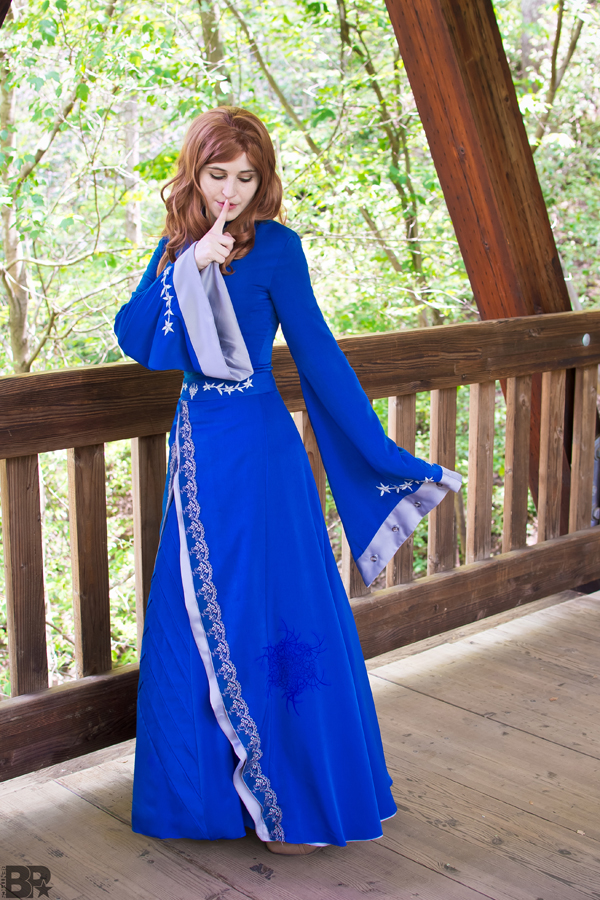
A Note on Textiles
For the truly obsessive when it comes to fabric choices, let’s discuss the greatshell in the room—textiles.
Most of the denizens of Roshar probably wouldn’t have access to what we think of as traditional cotton or wool blends, and they certainly wouldn’t be using the modern staple of polyesters. The way the world is designed, with storms sweeping across the world and the flora and fauna having evolved to survive them, renders most of what we think of as “normal” textiles unlikely. There is one notable exception—in Shinovar, where the storms are mild, farming of sheep and cotton plants is possible. But we have to assume that there wouldn’t be nearly enough grown and raised in Shinovar to outfit the entire rest of the world, which brings us to linen.
Linen was one of the chief textiles of our world for thousands of years in many societies across the globe, thanks to its versatility. It’s made from the cellulose fibers of the flax plant. While we have no evidence that flax is cultivated in Roshar, there are a number of other stalked plants which could be used for the same purpose (knobweed, for instance, which Kaladin milks for its sap in book 1, seems to have the right type of “stalk”). It does bear noting that Sanderson frequently mentions beechwood cotton, which—similar to linen—is fabricated from the cellulose pulp of the beech tree and has a soft, silky feel. Silk is also noted quite often, so we must infer that silkworms or an analogous life-form are being bred.
Hogshide leather is mentioned often throughout the books, so we can safely assume that creatures such as hogs or even skyeels could provide all the leather for society’s needs.
What does this all boil down to? If you want to make your cosplay as accurate as humanly possible, stick to linens, silks, and leather as much as you can.
Well, that’s all for now! Join me next time for information on some specific characters—namely Szeth, Wit/Hoid, and Veil—and how to make your own suit of Shardplate. I hope that this information helps you to buy or create the Stormlight Archive cosplay of your dreams!
Do you have any additional advice or techniques you’d like to share with the community, or photos of your own costumes you’ve already put together? Share them below in the comments, and happy creating!
Many thanks to Nightwing Whitehead, Kylah Coffey and Kathryn Rutkowski for their insight into Revolutionary and Civil War uniforms and designs.
*All page numbers referenced are from the kindle editions.
Lyndsey Luther has been cosplaying since 2003 and has made somewhere in the vicinity of 50 costumes. She’s competed in cosplay competitions both local and international, and is the director of Anime Boston’s Cosplay Masquerade. Her favorite costume to date is Howl from Howl’s Moving Castle; while wearing it she has free reign to wander around cons singing “Uptown Funk” to pretty ladies.











I don’t cosplay, but this makes me want to run out and make something and start cosplaying!
All the costumes by the contributors look wonderful! I think I saw Yashuntafun’s in person at JordanCon – the picture here does not show off Pattern. It was an amazing fractal painting!
Some of the others were at JordanCon too. Even better in person!
Thank you Lyndsey for putting this together.
I appreciate the use of source text and page references. Thanks for putting this together. Someday I hope to have the time or money to make use of it.
I’m working on a Shallan myself and clearly from this I’m on the right track! We have an ao dai pattern that is sadly no longer available. I feel like the ao dai is a slightly better base than a qipao, because of the loose slit on both sides– ie, it’s already the messenger/travelling dress. The plan is actually to alter it into the panel/pinafore design– the pattern already has princess seams, so that’s really quite doable. I’ve also found a nice voluminous petticoat.
The thing I have that I’d really like to pass on is that if you can find a nice resource for medieval costumes beyond Simplicity’s knockoffs– I have Patterns for Theatrical Costumes by Katherine Strand Holkeboer– in the late twelfth century the fashion for sleeves was to make them excessively long! I like having the reference, since it gives ideas of how the Alethi might design their sleeves, instead of just extending a normal one.
Great article! One thing that could use more detail, for both costumes and props, would be sources and techniques for LEDs. Infused gemstones could really help protect these cosplays from the risk of “What are you supposed to be?” that’s mentioned here. How to source and safely wire up LEDs as gems for decoration, hairstyles, or money?
@5, I was planning on doing a section specifically for wigs, jewelry and Stormlight later on! There’s just so much, and this article was getting rather lengthy already…
@@.-@, I will look into that! Interestingly most of the costumers I spoke to preferred the modern patterns – perhaps because they’re easier to find.
@@@@@ 4: there’ a Truly Victorian, Folkware, and another site that the SCA loves, who I can’t find at the moment.
Way cool, Lyndsey! Some incredibly talented folks here! And my thanks to all of them for allowing you to use their pictures, too.
I have to say, though, some of them are really intimidating… :D
I so wish I’d been involved in something like this when I was younger. It looks like so much fun. All I could play now is someone’s old granny. Of course if there was a old granny who could cast a few spells…
Anyway, wonderful costumes from all of you.
@9, you could be Sophie from Howl’s Moving Castle! (Yes I’m biased as I adore this film and book, so sue me)
Well, you can always be a random older woman in any culture, right? I’m constantly tempted to try a Thaylen outfit just for fun. The eyebrows!! :D But honestly, I mostly just go to signings as a master-servant; it’s a super easy costume, and works well for what I usually do – stand near the signing table and take pictures for people.
@9 Are you a Dragon Age fan? Wynne is an amazing Mage and fits the older age range you’re looking for!
This article was fascinating, btw. Loved the cosplay pictures!
This is SO cool!
It makes me very sad I am terrible at any kind of sewing and even more that all these wonderful events these cosplayers come together are held so storming far from me.
I modified a few Simplicity patterns to do my havah, and tried to use materials as authentic as possible (silk fabric &thread, shell buttons.
I wore it to the Firefight premiere and signing in 2015, where Brandon himself took a picture. Please see Tumblr post here:
http://erin-rei.tumblr.com/post/163243258965/i-saw-the-tor-post-on-stormlight-fashion-and-had
Thanks!
thanks for the visualization. :-) Great article
Ah, this is gorgeous. I always loved the description of the Havah and I want a Jasnah costume now, heh (purple is my favorite color, even).
“I’d like to take one moment here to say that if you choose to buy your outfits or commission them from someone else, it doesn’t make you any less of a cosplayer.” – as somebody who is completely worthless at all crafty things, I’d have to say the people who can make them on their own definitely have a special something :) Maybe it’s just a matter of admiring a skill I don’t have!